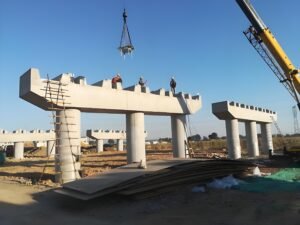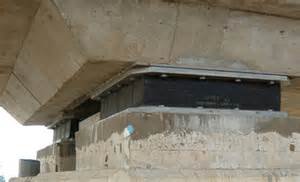Bridge bearings play an essential role in the functionality and safety of bridges. Yet, many people are unaware of what bridge bearings are and why they are so important. This article delves into the functions, arrangements, and replacement processes of bridge bearings, highlighting their significance in maintaining structural integrity.
Introduction
Bridges are complex structures designed to carry heavy loads while enduring various environmental and mechanical stresses. At the heart of these structures lie bridge bearings, critical components that ensure the seamless transfer of loads and allow for necessary movements. Understanding the role and maintenance of bridge bearings is vital for engineers and maintenance professionals to ensure the longevity and safety of bridges.

Functions of Bridge Bearings
Load Transfer and Stress Adaptation
Bridge bearings are crucial in transferring various loads from the bridge’s superstructure to its piers. They must adapt to changes in position caused by factors like load, temperature fluctuations, and concrete shrinkage. This adaptation ensures that the actual stresses on both the upper and lower structures align with the designed calculations, maintaining the bridge’s structural integrity.
Allowing Movements
One of the primary functions of bridge bearings is to accommodate both rotational and translational movements. These movements are necessary due to the dynamic loads and environmental changes that a bridge experiences. By allowing for these movements, bearings help prevent undue stress and potential damage to the bridge structure.
Ensuring Durability
Bridge bearings are designed to withstand significant stresses and strains while maintaining their performance over time. Ensuring the durability of these components is essential for the long-term stability of the bridge. Regular maintenance and timely replacement of bearings are crucial to sustaining the bridge’s performance and safety.
Arrangement of Bridge Bearings

Placement Based on Bridge Type
The placement of bridge bearings is primarily determined by the type and width of the bridge. For example, in a simple-supported girder bridge, a fixed bearing is placed at one end, while a movable bearing is positioned at the other end. This arrangement allows for the necessary movements while ensuring stability.
Specific Considerations for Different Bridges
Different types of bridges require specific bearing arrangements:
- Railway Bridges: Typically require one-way (longitudinal) movable bearings due to their narrow width and minimal transverse displacement.
- Road Girder Bridges: Due to their wider deck, these bridges need to accommodate potential transverse movements with appropriate bearings.
- Continuous Girder Bridges: Only one fixed support is usually provided to manage the expansion and contraction effectively. The fixed support is often placed near the middle fulcrum to balance the forces.
Special Cases
For curved continuous girder bridges, the bearing arrangement is critical in affecting the internal force distribution and allowing for free longitudinal and transverse movements. Additionally, when a bridge is located on a slope, the fixed bearing is placed at the lower end to counteract vertical loads effectively.
Replacement of Bridge Bearings
Importance of Replacement
Over time, bridge bearings and mat stones can deteriorate, compromising the bridge’s stability. Regular replacement is essential to maintain the bearings’ performance and ensure the bridge’s durability. A structured replacement process helps in achieving this goal effectively.
Construction Preparation
Before beginning the replacement process, thorough preparation is essential. This includes setting up a reliable working platform, calibrating jacks and oil pumps, selecting and testing new bearings, and cleaning the support areas. Proper planning and organization are crucial to ensure a smooth replacement process.
Jacking Construction
Jacking up the bridge requires careful coordination and control. The process involves:
- Temporarily closing the bridge to avoid accidents.
- Using jacks to lift the bridge under unified command, ensuring even and controlled lifting.
- Installing temporary supports to hold the bridge in place while the old bearings are removed and new ones are installed.
Key Considerations
- Lifting Position: Different jacking methods are required based on the bridge’s structure. For example, T-beams can be directly lifted with a jack, while hollow slabs and box beams require more careful positioning to avoid damage.
- Jacking Height: Controlling the jacking height is crucial to prevent damage to the bridge deck and ancillary facilities.
- Bearing Pad Stone: Ensuring the top surface elevation of the bearing pad stone is consistent is essential for proper bearing replacement.
Construction Precautions for Bridge Bearing Replacement
Ensuring Safety and Accuracy
Replacing bridge bearings is a significant undertaking that requires attention to detail. Key precautions include:
- Accurate Jacking: The jacking position and height must be carefully managed to avoid structural damage.
- Bearing Pad Stone: Proper maintenance of the bearing pad stone is necessary to prevent stress concentrations and breakage.
Monitoring and Observation
Throughout the replacement process, continuous monitoring of stress and deflection is vital. Observation points should be set up to track displacement changes and ensure the stability of the bridge during the operation.
Conclusion
Bridge bearings are indispensable components that ensure the stability, durability, and functionality of bridges. From transferring loads and accommodating movements to facilitating maintenance and replacements, their role cannot be overstated. Given the increasing number of bridges worldwide and the critical importance of maintaining structural integrity, understanding and managing bridge bearings is essential. Regular inspection and timely replacement are key to extending the lifespan and safety of bridges.
Summary
Bridge bearings play a critical role in maintaining the integrity and functionality of bridges. They ensure the transfer of loads, accommodate necessary movements, and contribute to the durability of the structure. Proper placement and regular maintenance, including timely replacement, are essential to keep bridges safe and operational. Understanding these aspects is vital for engineers and maintenance professionals involved in bridge construction and upkeep.
FAQ
What are bridge bearings?
Bridge bearings are structural components that connect the bridge superstructure to the substructure, allowing for the transfer of loads and accommodation of movements.
Why are bridge bearings important?
Bridge bearings ensure that loads are effectively transferred from the superstructure to the piers, accommodate necessary movements, and help maintain the overall structural integrity and durability of the bridge.
How are bridge bearings arranged?
The arrangement of bridge bearings depends on the type and width of the bridge. For example, simple-supported girder bridges have a fixed bearing at one end and a movable bearing at the other. The arrangement varies for railway bridges, road girder bridges, and continuous girder bridges.
When should bridge bearings be replaced?
Bridge bearings should be replaced when they show signs of deterioration or when their performance diminishes. Regular inspections help determine the appropriate time for replacement to ensure the bridge’s stability and safety.
What precautions should be taken during the replacement of bridge bearings?
During the replacement of bridge bearings, it is crucial to control the jacking height, accurately position the jacks, and ensure the proper maintenance of bearing pad stones. Continuous monitoring of stress and deflection is also essential to avoid structural damage.



